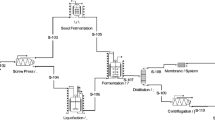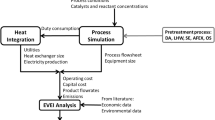Abstract
Sugarcane bagasse is used as a fuel in conventional bioethanol production, providing heat and power for the plant; therefore, the amount of surplus bagasse available for use as raw material for second generation bioethanol production is related to the energy consumption of the bioethanol production process. Pentoses and lignin, byproducts of the second generation bioethanol production process, may be used as fuels, increasing the amount of surplus bagasse. In this work, simulations of the integrated bioethanol production process from sugarcane, surplus bagasse and trash were carried out. Selected pre-treatment methods followed, or not, by a delignification step were evaluated. The amount of lignocellulosic materials available for hydrolysis in each configuration was calculated assuming that 50% of sugarcane trash is recovered from the field. An economic risk analysis was carried out; the best results for the integrated first and second generation ethanol production process were obtained for steam explosion pretreatment, high solids loading for hydrolysis and 24–48 h hydrolysis. The second generation ethanol production process must be improved (e.g., decreasing required investment, improving yields and developing pentose fermentation to ethanol) in order for the integrated process to be more economically competitive.









Similar content being viewed by others
References
Balat M, Balat H, Öz C (2008) Progress in bioethanol processing. Prog Energy Combust Sci 34:551–573
Brasil (2010) Ministry of Development, Industry and Foreign Trade. Available from http://www.mdic.gov.br. Accessed on March 20, 2010
Carrasco C, Baudel HM, Sendelius J, Modig T, Roslander C, Galbe M, Hahn-Hägerdal B, Zacchi G, Lidén G (2010) SO2-catalyzed steam pretreatment and fermentation of enzymatically hydrolyzed sugarcane bagasse. Enzyme Microb Technol 46:64–73
CEPEA—Center for Advanced Studies on Applied Economics (2010) Available from http://www.cepea.usp.br. Accessed February 20, 2010
Chen JCP, Chou CC (1993) Cane sugar handbook: a manual for cane sugar manufacturers and their chemists. Wiley, London
Demirbaş A (2001) Relationships between lignin contents and heating values of Biomass. Energy Convers Manag 42:183–188
Dias MOS, Ensinas AV, Nebra SA, Maciel Filho R, Rossell CEV, Maciel MRW (2009) Production of bioethanol and other bio-based materials from sugarcane bagasse: integration to conventional bioethanol production process. Chem Eng Res Des 87:1206–1216
Dias MOS, Ensinas AV, Modesto M, Nebra SA, Maciel Filho R, Rossell CEV (2009) Energy efficiency in anhydrous bioethanol production from sugarcane. Part 1: Process simulation and thermal integration. Proc ECOS 2009:425–436
Dias MOS, Maciel Filho R, Rossell CEV (2007) Efficient cooling of fermentation vats in ethanol production—Part 1. Sugar J 70:11–17
Dodić S, Popov S, Dodić J, Ranković J, Zavargo Z, Mučibabić RJ (2009) Bioethanol production from thick juice as intermediate of sugar beet processing. Biomass Bioenergy 33:822–827
Ensinas AV, Nebra SA, Lozano MA, Serra LM (2007) Analysis of process steam demand reduction and electricity generation in sugar and ethanol production from sugarcane. Energy Convers Manag 48:2978–2987
Franceschin G, Zamboni A, Bezzo F, Bertucco A (2008) Ethanol from corn: a technical and economical assessment based on different scenarios. Chem Eng Res Des 86:488–498
Garcia DR (2009) Determination of kinetics data of the pretreatment of sugarcane bagasse with alkaline hydrogen peroxide and subsequent enzymatic hydrolysis. MSc Dissertation. School of Chemical Engineering, University of Campinas (in Portuguese). Available from http://cutter.unicamp.br/document/?code=000442925. Accessed March 29, 2010
Goldemberg J (2007) Ethanol for a sustainable energy future. Science 315:808–810
Hassuani SJ, Leal MRLV, Macedo IC (eds) (2005) Biomass power generation—sugarcane bagasse and trash. CTC and PNUD, Piracicaba
Hoch PM, Espinosa J (2008) Conceptual design and simulation tools applied to the evolutionary optimization of a bioethanol purification plant. Ind Eng Chem Res 47:7381–7389
Intelligen, Inc. (2009) SuperPro Designer, v. 7.5
JBEI (2010) Corn Stover to Ethanol Model. Available from http://www.econ.jbei.org. Accessed March 29, 2010
Kuo C-H, Lee C-K (2009) Enhanced enzymatic hydrolysis of sugarcane bagasse by N-methylmorpholine-N-oxide pretreatment. Bioresour Technol 100:866–871
Larson ED, Williams RH, Leal MRLV (2001) A review of biomass integrated-gasifier/gas turbine combined cycle technology and its application in sugarcane industries, with an analysis for Cuba. Energy Sustain Dev 5(1):54–76
Maas RHW, Bakker RR, Boersma AR, Bisschops I, Pels JR, de Jong E, Weusthuis RA, Reith H (2008) Pilot-scale conversion of lime-treated wheat straw into bioethanol: quality assessment of bioethanol and valorization of side streams by anaerobic digestion and combustion. Biotechnol Biofuels 1:14. doi:10.1186/1754-6834-1-14
Macedo IC, Seabra JEA, Silva JEAR (2008) Green house gases emissions in the production and use of ethanol from sugarcane in Brazil: the 2005/2006 averages and a prediction for 2020. Biomass Bioenergy 32(7):582–595
Martín C, González Y, Fernández T, Thomsen AB (2006) Investigation of cellulose convertibility and ethanolic fermentation of sugarcane bagasse pretreated by wet oxidation and steam explosion. J Chem Technol Biotechnol 81:1669–1677
Mesa L, González E, Ruiz E, Romero I, Cara C, Felissia F, Castro E (2010) Preliminary evaluation of organosolv pre-treatment of sugar cane bagasse for glucose production: application of 23 experimental design. Appl Energy 87:109–114
Novozymes (2009) Enabling cost efficient enzymatic hydrolysis for biomass-to-ethanol conversion. In: 7th Global clean technology conference, New York. Available from http://www.novozymes.com/en/MainStructure/Investor/Events+and+presentations/Presentations. Accessed March 29, 2010
Pandey A, Soccol CR, Nigam P, Soccol VT (2000) Biotechnological potential of agro-industrial residues. I: Sugarcane Bagasse. Bioresour Technol 74:69–80
Pfeffer M, Wukovits W, Beckmann G, Friedl A (2007) Analysis and decrease of the energy demand of bioethanol-production by process integration. Appl Therm Eng 27:2657–2664
Rabelo SC, Maciel Filho R, Costa AC (2008) A comparison between lime and alkaline hydrogen peroxide pretreatments of sugarcane bagasse for ethanol production. Appl Biochem Biotechnol 148:45–58
Rabelo SC, Garzón Fuentes LL, Garcia DR, Maciel Filho R, Costa AC (2009) Influence of biomass concentration increase in the pretreatment stage of sugarcane bagasse in the enzymatic hydrolysis profile. XXV Congreso Colombiano de Ingeniería Química, Medellín
Rao K, Chelikani S, Relue P, Varanasi S (2008) A novel technique that enables efficient conduct of simultaneous isomerization and fermentation (SIF) of xylose. Appl Biochem Biotechnol 146:101–117
Rosgaard L, Pedersen S, Meyer AS (2007) Comparison of different pretreatment strategies for enzymatic hydrolysis of wheat and barley straw. Appl Biochem Biotechnol 143:284–296
Saxena RC, Adhikari DK, Goyal HB (2009) Biomass-based energy fuel through biochemical routes: a review. Renew Sustain Energy Rev 13:167–178
Sánchez ÓJ, Cardona CA (2008) Trends in biotechnological production of fuel ethanol from different feedstocks. Bioresour Technol 99:5270–5295
Seabra JEA, Tao L, Chum HL, Macedo IC (2010) A techno-economic evaluation of the effects of centralized cellulosic ethanol and co-products refinery options with sugarcane mill clustering. Biomass Bioenergy 34:1065–1078
Silverstein RA, Chen Y, Sharma-Shivappa RR, Boyette MD, Osborne J (2007) A comparison of chemical pretreatment methods for improving saccharification of cotton stalks. Bioresour Technol 98:3000–3011
Soccol CR et al (2009) Bioethanol from lignocelluloses: status and perspectives in Brazil. Bioresour Technol 101:4820–4825
Srinivasan S (2009) The food v. fuel debate: a nuanced view of incentive structures. Renewable Energy 34:950–954
UDOP (Union of Biofuel Producers) (2010) Available from http://www.udop.com.br/index.php?item=cana. Accessed February 20, 2010
Walter A, Ensinas AV (2010) Combined production of second-generation biofuels and electricity from sugarcane residues. Energy 35:874–879
Acknowledgments
The authors would like to thank Dedini Indústrias de Base S/A for supplying investment data.
Author information
Authors and Affiliations
Corresponding author
Additional information
This article is based on a presentation at the 32nd Symposium on Biotechnology for Fuels and Chemicals.
Rights and permissions
About this article
Cite this article
Dias, M.O.S., da Cunha, M.P., Maciel Filho, R. et al. Simulation of integrated first and second generation bioethanol production from sugarcane: comparison between different biomass pretreatment methods. J Ind Microbiol Biotechnol 38, 955–966 (2011). https://doi.org/10.1007/s10295-010-0867-6
Received:
Accepted:
Published:
Issue Date:
DOI: https://doi.org/10.1007/s10295-010-0867-6




